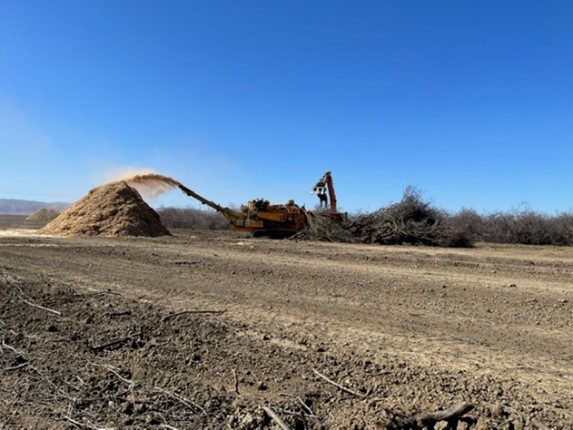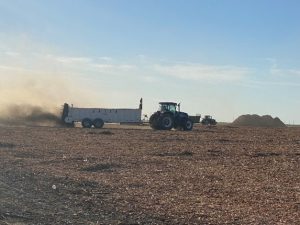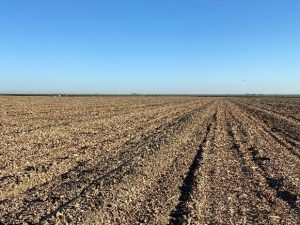
Goals for the future can often be set aside when they are overshadowed by a crises in the present.
Over the past two growing seasons, California almond growers have been hit with shipment delays, labor issues and water scarcity among other challenges, but they continue to make progress toward the almond industry’s zero waste goals.
“Beyond the kernel” is how Josette Lewis, Almond Board of California’s chief scientific officer, describes the development of new and higher-value uses for almond byproducts.
“Growers are telling us they place a high priority on increasing the value of co-products,” Lewis said.
The 2025 goal of zero waste has two features, Lewis said. Everything grown in the orchard is put to productive use, and those uses deliver optimal value back to the industry. Zero waste means that all parts of the trees, almond hulls and shells are directed to enhancing the environment or productivity for the grower and other industries. In years past, woody biomass from an orchard, whole trees or prunings, were piled and burned or chipped and hauled to a co-generation facility where they were used to create energy. Hulls and shells were used for livestock feed or bedding.
Open field burning is being phased out in California and most co-gen plants are no longer in operation. The market for hulls as livestock feed has shrunk while almond production has increased.
Currently, more almond growers are turning to whole-orchard recycling (WOR) as a use for woody biomass when they push out old orchards. Almond Board-funded research enabled this new practice and supported opening new incentives from state and federal agencies. Research is also finding new uses for the other co-products from the almond industry.
Lewis reported that most recent data showed about 50% of almond orchard removals by growers in the stewardship program were whole-orchard recycled, meaning that the trees were ground into chips on-site, spread over the orchard site and incorporated into the soil. This practice was just in its infancy in 2015, and Lewis said the rapid rate of adoption was due to the significant benefits gained in soil and tree health.
Smaller growers do have challenges in adopting WOR, Lewis said. Financial incentives from Natural Resources Conservation Service and the CDFA’s Healthy Soil program as well as the San Joaquin air district help offset costs, but finding companies willing to bring equipment for small acreage is still a challenge.
UC research identified advantages to WOR in the past six years, noting that it increased the yield and water use efficiency of the next orchard planted. It also sequestered carbon in the soil, improved soil structure and did not show problems for increased disease.
The net benefit to the next orchard is being realized, Lewis said, as research has shown a water savings of 19% and a 20% increase in production. This is driving adoption of WOR along with increasing availability of orchard recycling machinery and financial incentives.

Expanding Markets for Hulls and Shells
When it comes to optimal use, Lewis said the focus is on expanding markets for hulls and shells beyond dairy feed and bedding. It is important, she noted, that new uses need to scale-up and be commercially viable to achieve greater value back to almond growers.
There are two exciting opportunities for almond byproducts on the horizon, Lewis said. One is development of almond hulls as a value-added ingredient for human consumption.
Examples of uses for the powdered hull product would be in bakery goods as fiber or replacing part of the flour in battered & fried foods, which decreases oil uptake, and as a stabilizer for nut butters, replacing palm oil. Data on the use of the hull product will be shared with food companies, Lewis said.
Including almond hulls in poultry feed also performs well for both broiler and egg laying chickens. The Almond Board noted that research is nearly complete and will be shared with the California poultry industry to open new markets for hulls. Almond shells as a soil amendment is another option as research shows that adding shells to the soil can immobilize nitrogen and keep it from leaching below the root zone.
While some second-generation biofuel companies have started to operate in the Central Valley, the scale has not yet developed to create significant markets for woody biomass or almond co-products. To address this, the Almond Board’s Biomass Working Group is considering investment in the evaluation and rating of the supply chain reliability of feedstocks for second-generation biofuels. Lewis said the goal is to elevate the visibility to investors that the volume and infrastructure to supply large-scale generation of biofuels is there in the Central Valley.

Pomona Farming Committed to Zero Waste
One of the larger almond producers in California, Pomona Farming, is committed to zero waste in orchards. Ceil Howe III, president of California Agribusiness, and Mike Mendes, executive vice president of California Farming Operations, said one of their main goals with almond production is WOR when orchards are no longer productive.
“Our focus in the past year has been on trade and movement of product as well as prices, as it should be,” said Howe. “That doesn’t mean we can’t keep moving toward the goal of zero waste.”
Howe reported that Pomona Farming has adopted five main sustainability goals for 2025, with one focused on creating zero waste. The goal, he said, is to put everything they grow to optimal use.
Pomona Farming has created its own environmental Social Governance platform, Pomona Cares. Deanna Eakin, managing director of Pomona Cares, said the business has adopted five main sustainability goals for 2025, with one focused on creating zero waste. That means putting everything they grow to optimal use, Eakin said.
“Orchard recycling is just one piece of our sustainability mission,” Eakin said. “This past month, the team has worked very hard to complete the first field in Firebaugh. We will continue to monitor the fields completed and record our observations.”
Pomona Farming has implemented WOR on 1,800 acres of almonds in Firebaugh and 2,200 acres in Kern County as it replaces aging trees.
Mendes said wood chippings from orchard removal and prunings have valuable resources that can be added back for soil remediation.
Howe said they also recycle all the irrigation system plastic when an orchard is removed as well as all the cardboard containers. The plastic irrigation tubing is rolled up and taken to a recycling center where it is cleaned and used to make other plastic items.
As for the shells, Howe said they are evaluating a plan for their use, possibly to add organic matter. Another use that is being adopted is for dust control on orchard access roads.
“We are looking at the return-on-investment in reaching these goals,” Howe said. There must be a combination of good investment and a clean and safe method of use for orchard byproducts.

Cecilia Parsons | Associate Editor
Cecilia Parsons has lived in the Central Valley community of Ducor since 1976, covering agriculture for numerous agricultural publications over the years. She has found and nurtured many wonderful and helpful contacts in the ag community, including the UCCE advisors, allowing for news coverage that focuses on the basics of food production.
She is always on the search for new ag topics that can help growers and processors in the San Joaquin Valley improve their bottom line.
In her free time, Cecilia rides her horse, Holly in ranch versatility shows and raises registered Shetland sheep which she exhibits at county and state fairs during the summer.















